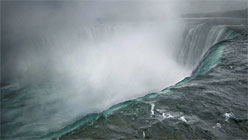Most people associate Annie Leibovitz with her staged photos of movie stars like Meryl Streep, rockers like Mick Jagger and entertainment conglomerates like Disney, which recently commissioned the photographer to execute a slick series of “Dream Portraits” (think Taylor Swift dressed up as Rapunzel, Queen Latifah costumed as Ursula, Tina Fey digitally shrunk to the size of Tinker Bell). While the 70 photographs on display for Annie Leibovitz: Pilgrimage, through September 8, 2013, at the San Jose Museum of Art, are not as obviously star-obsessed as any of those examples, they are still, weirdly, celebrity portraits.
Organized around the conceit that places like Elvis Presley’s Graceland, Georgia O’Keefe’s Abiquiu, Ansel Adams’ darkroom and Pete Seeger’s garage are destinations to which Leibovitz has always wanted to make a pilgrimage, the show is mostly a catalog of stuff owned or accumulated by famous people. The only “pure” places in the show are Niagara Falls and Old Faithful, although in their own way, those iconic natural wonders are celebrities, too.

Sigmund Freud’s couch, Freud Museum, 20 Maresfield Gardens, London, 2009. c Annie Leibovitz.
As is Leibovitz. In fact, walking through the exhibition, it was impossible not to think about what was going on in Leibovitz’s much-publicized life when she was taking these pictures. Back in 2009, when Leibovitz was snapping photos of Sigmund Freud’s couch, the photographer was raking in a reported quarter-million-dollars per day shooting fashion for Louis Vuitton. Despite her extraordinarily privileged position, she was $24 million in debt and about to lose the rights to her life’s work, which she had put up as collateral. Leibovitz’s self-inflicted financial woes (she appears to have been seduced by the remodeling muse) have since been resolved, but in that context, the artist’s multiple pilgrimages hither and yon between 2009 and 2011 feel as much like excuses to escape New York as boxes to check on one’s bucket list.
And so, what of the choices Leibovitz made, both in terms of the places she visited and the pictures she took once there? Well, not surprisingly, we get a number of photographs about photographers and photography. There are peeks inside Ansel Adams’ darkroom in Carmel, as well as a series of Leibovitz’s photos of Adams’ photos of Yosemite Valley, which is presumably Leibovitz’s way of paying homage to a photographer she’s always admired, if never emulated. Closer to the artist’s heart, I expect, is the Isle of Wight home of Julia Margaret Cameron, a Victorian-era photographer who shot portraits of Charles Darwin and Virginia Woolf’s mother, among many others, making her something of a prototype for Leibovitz.




